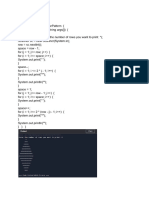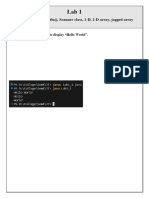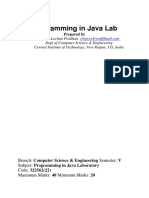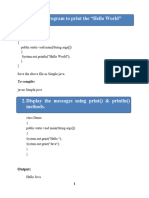Java Practical Programs
Uploaded by
sujanak0203Java Practical Programs
Uploaded by
sujanak02031
1 . Write a Java program to print Fibonacci series using for loop. int[][] matrix1 = {
Source code: {1, 2, 3},
class FibonacciSeries { {4, 5, 6}
public static void main(String[] args) { };
int n = 10; // Number of terms to print
int firstTerm = 0; int[][] matrix2 = {
int secondTerm = 1; {7, 8},
System.out.println("Fibonacci Series up to " + n + " terms:"); {9, 10},
for (int i = 1; i <= n; ++i) { {11, 12}
System.out.print(firstTerm + " "); };
// Compute the next term
int nextTerm = firstTerm + secondTerm; // Calculate the product of the matrices
firstTerm = secondTerm; int[][] product = multiplyMatrices(matrix1, matrix2);
secondTerm = nextTerm;
} // Print the resulting product matrix
} System.out.println("Product of the matrices:");
} printMatrix(product);
Explanation }
1. Variables Initialization:
o n: The number of terms in the Fibonacci series to print. // Method to multiply two matrices
o firstTerm: Initialized to 0, the first term in the Fibonacci series. public static int[][] multiplyMatrices(int[][] firstMatrix, int[][] secondMatrix) {
o secondTerm: Initialized to 1, the second term in the Fibonacci int rows1 = firstMatrix.length;
series. int cols1 = firstMatrix[0].length;
2. For Loop: int cols2 = secondMatrix[0].length;
o Loop runs from 1 to n.
o Prints the current firstTerm. // Initialize the product matrix
o Computes the next term in the series by adding the current int[][] product = new int[rows1][cols2];
firstTerm and secondTerm.
o Updates firstTerm to the current secondTerm and secondTerm to // Perform matrix multiplication
the computed next term. for (int i = 0; i < rows1; i++) {
Sample Output: for (int j = 0; j < cols2; j++) {
Compile: javac FibonacciSeries.java for (int k = 0; k < cols1; k++) {
Run: java FibonacciSeries product[i][j] += firstMatrix[i][k] * secondMatrix[k][j];
Fibonacci Series up to 10 terms: }
0 1 1 2 3 5 8 13 21 34 }
2 . Write a Java program to calculate multiplication of 2 matrices. }
Source code:
class MatrixMultiplication { return product;
public static void main(String[] args) { }
// Define two matrices
// Method to print a matrix
K.G.Mahendra Reddy MCA
Lec in Computer Science
2
public static void printMatrix(int[][] matrix) {
for (int[] row : matrix) { // Constructor
for (int element : row) { public Rectangle() {
System.out.print(element + " "); this.length = 0;
} this.width = 0;
System.out.println(); }
}
} // Method to read attributes from the user
} public void readAttributes() {
Explanation Scanner scanner = new Scanner(System.in);
1. Matrices Definition: System.out.print("Enter the length of the rectangle: ");
o matrix1 and matrix2 are the two matrices to be multiplied. this.length = scanner.nextDouble();
2. Multiplication Method: System.out.print("Enter the width of the rectangle: ");
o The multiplyMatrices method performs the matrix multiplication. this.width = scanner.nextDouble();
It takes two matrices as input and returns their product. }
o The product matrix is initialized with dimensions based on the
number of rows of the first matrix and the number of columns of // Method to calculate the perimeter
the second matrix. public double calculatePerimeter() {
o Nested loops iterate through the rows of the first matrix, columns return 2 * (length + width);
of the second matrix, and columns of the first matrix (which }
equals the number of rows of the second matrix).
o The multiplication of corresponding elements and summation are // Method to calculate the area
performed to fill the product matrix. public double calculateArea() {
3. Printing the Matrix: return length * width;
o The printMatrix method prints the resulting product matrix row by }
row.
Sample Output: // Method to display the rectangle's properties
Compile: javac MatrixMultiplication java public void displayProperties() {
Run: java MatrixMultiplication System.out.println("Length: " + length);
Product of the matrices: System.out.println("Width: " + width);
58 64 System.out.println("Perimeter: " + calculatePerimeter());
139 154 System.out.println("Area: " + calculateArea());
3 . Create a class Rectangle. The class has attributes length and width. It }
should have methods that calculate the perimeter and area of the rectangle. It
should have read Attributes method to read length and width from user. public static void main(String[] args) {
Source code: Rectangle rectangle = new Rectangle();
import java.util.Scanner; rectangle.readAttributes();
class Rectangle { rectangle.displayProperties();
private double length; }
private double width; }
Explanation
K.G.Mahendra Reddy MCA
Lec in Computer Science
3
1. Attributes: // Overloaded method to add three integers
o length and width: These are private attributes of the Rectangle public int add(int a, int b, int c) {
class. return a + b + c;
2. Constructor: }
o Initializes length and width to 0.
3. Method readAttributes: // Overloaded method to add two double values
o Uses a Scanner object to read length and width from the user public double add(double a, double b) {
input. return a + b;
4. Method calculatePerimeter: }
o Calculates the perimeter of the rectangle using the formula 2 *
(length + width). // Overloaded method to add three double values
5. Method calculateArea: public double add(double a, double b, double c) {
o Calculates the area of the rectangle using the formula length * return a + b + c;
width. }
6. Method displayProperties:
o Prints the length, width, perimeter, and area of the rectangle. public static void main(String[] args) {
7. Main Method: MethodOverloadingExample example = new MethodOverloadingExample();
o Creates an instance of Rectangle.
o Calls the readAttributes method to get user input for length and // Calling overloaded methods
width. System.out.println("Sum of 2 integers (10 + 20): " + example.add(10, 20));
o Calls the displayProperties method to display the rectangle's System.out.println("Sum of 3 integers (10 + 20 + 30): " + example.add(10,
properties. 20, 30));
Sample Output: System.out.println("Sum of 2 doubles (10.5 + 20.5): " + example.add(10.5,
Compile: javac Rectangle. java 20.5));
Run: java Rectangle System.out.println("Sum of 3 doubles (10.5 + 20.5 + 30.5): " +
Enter the length of the rectangle: 5 example.add(10.5, 20.5, 30.5));
Enter the width of the rectangle: 3 }
Length: 5.0 }
Width: 3.0 Explanation
Perimeter: 16.0 1. Method Overloading:
o First Method: public int add(int a, int b)
Area: 15.0
4 . Write a Java program that implements method overloading. Takes two integers and returns their sum.
Source code: o Second Method: public int add(int a, int b, int c)
class MethodOverloadingExample { Takes three integers and returns their sum.
o Third Method: public double add(double a, double b)
// Method to add two integers Takes two double values and returns their sum.
public int add(int a, int b) { o Fourth Method: public double add(double a, double b, double c)
return a + b; Takes three double values and returns their sum.
} 2. Main Method:
o Creates an instance of MethodOverloadingExample.
K.G.Mahendra Reddy MCA
Lec in Computer Science
4
o Calls the overloaded add methods with different parameters. Explanation
o Prints the results. 1. Import Statements:
3. Sample Output: o import java.util.Arrays;: Imports the Arrays class which contains
Sample Output: the sort method.
Compile: javac MethodOverloadingExample. java o import java.util.Scanner;: Imports the Scanner class for reading
Run: java MethodOverloadingExample user input.
Sum of 2 integers (10 + 20): 30 2. Main Method:
Sum of 3 integers (10 + 20 + 30): 60 o Creates a Scanner object to read input from the user.
Sum of 2 doubles (10.5 + 20.5): 31.0 o Reads the number of names from the user.
Sum of 3 doubles (10.5 + 20.5 + 30.5): 61.5 o Initializes an array of String to store the names.
5 . Write a Java program for sorting a given list of names in ascending order. o Uses a loop to read each name and store it in the array.
Source code: o Sorts the array of names using Arrays.sort.
import java.util.Arrays; o Prints the sorted names.
import java.util.Scanner; Sample Output:
Compile: javac SortNames. java
class SortNames { Run: java SortNames
public static void main(String[] args) { Enter the number of names: 5
Scanner scanner = new Scanner(System.in); Enter the names:
John
// Read the number of names Alice
System.out.print("Enter the number of names: "); Bob
int numberOfNames = scanner.nextInt(); Eve
scanner.nextLine(); // Consume newline Charlie
// Read the names Names in ascending order:
String[] names = new String[numberOfNames]; Alice
System.out.println("Enter the names:"); Bob
for (int i = 0; i < numberOfNames; i++) { Charlie
names[i] = scanner.nextLine(); Eve
} John
6 . Write a Java program that displays the number of characters, lines and
// Sort the names
Arrays.sort(names); words in a text file.
Source code:
// Display the sorted names import java.io.BufferedReader;
System.out.println("Names in ascending order:"); import java.io.FileReader;
for (String name : names) { import java.io.IOException;
System.out.println(name);
} class FileStatistics {
} public static void main(String[] args) {
} // Specify the file path
K.G.Mahendra Reddy MCA
Lec in Computer Science
5
String filePath = "example.txt"; o The program reads each line of the file using reader.readLine().
o For each line, the lineCount is incremented.
// Variables to hold counts o The charCount is incremented by the length of the line.
int lineCount = 0; o The line is split into words using line.split("\\s+"), which splits the
int wordCount = 0; line based on whitespace. The number of words in the line is
int charCount = 0; added to wordCount.
5. Exception Handling:
try (BufferedReader reader = new BufferedReader(new FileReader(filePath))) o The try-with-resources statement ensures that the BufferedReader
{ is closed automatically after the block is executed.
String line; o If an IOException occurs, an error message is printed.
6. Displaying the Counts:
// Read the file line by line
o The counts of lines, words, and characters are displayed using
while ((line = reader.readLine()) != null) {
System.out.println.
lineCount++;
Example:
charCount += line.length();
Suppose example.txt contains the following text:
// Split the line into words based on whitespace Hello world!
String[] words = line.split("\\s+"); This is a test file.
wordCount += words.length; It contains multiple lines.
} Sample Output:
} catch (IOException e) { Compile: javac FileStatistics. java
System.out.println("An error occurred while reading the file: " + Run: java FileStatistics
e.getMessage()); Number of lines: 3
} Number of words: 9
Number of characters: 55
// Display the counts 7 . Write a Java program to implement various types of inheritance
System.out.println("Number of lines: " + lineCount); i. Single
System.out.println("Number of words: " + wordCount); ii. Multi-Level
System.out.println("Number of characters: " + charCount); iii. Hierarchical
} iv. Hybrid
} i. Single Inheritance
Explanation In Single Inheritance, a class inherits from one parent class.
1. File Path: Source code:
o String filePath = "example.txt";: Specifies the path to the text file. // Parent class
You can change this to the path of your text file. class Animal {
2. Counts Initialization: void eat() {
o lineCount, wordCount, and charCount are initialized to 0. System.out.println("This animal eats food.");
3. BufferedReader: }
o A BufferedReader wrapped around a FileReader is used to read }
the file line by line.
4. Reading the File: // Child class
K.G.Mahendra Reddy MCA
Lec in Computer Science
6
class Dog extends Animal { puppy.eat();
void bark() { puppy.bark();
System.out.println("The dog barks."); puppy.play();
} }
} }
iii. Hierarchical Inheritance
class SingleInheritance { In Hierarchical Inheritance, multiple classes inherit from a single parent class.
public static void main(String[] args) { Source code:
Dog dog = new Dog(); // Parent class
dog.eat(); class Animal {
dog.bark(); void eat() {
} System.out.println("This animal eats food.");
} }
ii. Multi-Level Inheritance }
In Multi-Level Inheritance, a class is derived from another class which is also
derived from another class. // Child class 1
Source code: class Dog extends Animal {
// Grandparent class void bark() {
class Animal { System.out.println("The dog barks.");
void eat() { }
System.out.println("This animal eats food."); }
}
} // Child class 2
class Cat extends Animal {
// Parent class void meow() {
class Dog extends Animal { System.out.println("The cat meows.");
void bark() { }
System.out.println("The dog barks."); }
}
} class HierarchicalInheritance {
public static void main(String[] args) {
// Child class Dog dog = new Dog();
class Puppy extends Dog { dog.eat();
void play() { dog.bark();
System.out.println("The puppy plays.");
} Cat cat = new Cat();
} cat.eat();
cat.meow();
class MultiLevelInheritance { }
public static void main(String[] args) { }
Puppy puppy = new Puppy(); iv. Hybrid Inheritance
K.G.Mahendra Reddy MCA
Lec in Computer Science
7
Hybrid Inheritance is a combination of two or more types of inheritance. However, Explanation
Java does not support multiple inheritance directly to avoid complexity and 1. Single Inheritance:
simplify the language. But we can achieve Hybrid Inheritance using interfaces. o Animal is the parent class.
Source code: o Dog is the child class that inherits from Animal.
// Interface 2. Multi-Level Inheritance:
interface CanFly { o Animal is the grandparent class.
void fly(); o Dog is the parent class that inherits from Animal.
} o Puppy is the child class that inherits from Dog.
3. Hierarchical Inheritance:
// Base class o Animal is the parent class.
class Animal { o Dog and Cat are child classes that inherit from Animal.
void eat() { 4. Hybrid Inheritance:
System.out.println("This animal eats food."); o Animal is the base class.
} o CanFly is an interface.
} o Bird inherits from Animal and implements the CanFly interface.
o Dog inherits from Animal.
// Derived class 1
8 . Write a java program to implement runtime polymorphism.
class Bird extends Animal implements CanFly {
Source code:
public void fly() {
// Parent class
System.out.println("The bird flies.");
Class Animal {
}
void sound() {
}
System.out.println("Animal makes a sound");
}
// Derived class 2
}
class Dog extends Animal {
void bark() {
// Child class 1
System.out.println("The dog barks.");
class Dog extends Animal {
}
@Override
}
void sound() {
System.out.println("Dog barks");
class HybridInheritance {
}
public static void main(String[] args) {
}
Bird bird = new Bird();
bird.eat();
// Child class 2
bird.fly();
class Cat extends Animal {
@Override
Dog dog = new Dog();
void sound() {
dog.eat();
System.out.println("Cat meows");
dog.bark();
}
}
}
}
K.G.Mahendra Reddy MCA
Lec in Computer Science
8
public void run() {
public class RuntimePolymorphism { try {
public static void main(String[] args) { while (true) {
// Parent reference, child object System.out.println("Good Morning");
Animal myAnimal; Thread.sleep(1000); // Sleep for 1 second
}
// Dog object } catch (InterruptedException e) {
myAnimal = new Dog(); System.out.println(e);
myAnimal.sound(); // Calls Dog's sound method }
}
// Cat object }
myAnimal = new Cat();
myAnimal.sound(); // Calls Cat's sound method // Thread to display "Hello" every 2 seconds
} class HelloThread extends Thread {
} public void run() {
Explanation try {
1. Parent Class: while (true) {
o Animal class has a method sound which prints a generic sound. System.out.println("Hello");
2. Child Classes: Thread.sleep(2000); // Sleep for 2 seconds
o Dog class overrides the sound method to print "Dog barks". }
o Cat class overrides the sound method to print "Cat meows". } catch (InterruptedException e) {
3. Main Method: System.out.println(e);
o An Animal reference is created. }
o The Animal reference is assigned to a Dog object and the sound }
method is called. This demonstrates runtime polymorphism as the }
Dog class's sound method is executed.
o The Animal reference is then assigned to a Cat object and the // Thread to display "Welcome" every 3 seconds
sound method is called. This demonstrates runtime polymorphism class WelcomeThread extends Thread {
as the Cat class's sound method is executed. public void run() {
Sample Output: try {
Compile: javac Animal. java while (true) {
Run: java Animal System.out.println("Welcome");
Dog barks Thread.sleep(3000); // Sleep for 3 seconds
Cat meows }
9 . Write a Java program to create three threads and that displays “good } catch (InterruptedException e) {
morning”, for every one second, “hello” for every 2 seconds and “welcome” System.out.println(e);
for every 3 seconds by using extending Thread class. }
Source code: }
// Thread to display "Good Morning" every 1 second }
class GoodMorningThread extends Thread {
class MultiThreadExample {
K.G.Mahendra Reddy MCA
Lec in Computer Science
9
public static void main(String[] args) { 10 . Implement a Java program for handling mouse events when the mouse
// Create thread instances entered, exited, clicked, pressed, released, dragged and moved in the client
GoodMorningThread goodMorningThread = new GoodMorningThread(); area.
HelloThread helloThread = new HelloThread(); Source code:
WelcomeThread welcomeThread = new WelcomeThread(); import javax.swing.*;
import java.awt.event.*;
// Start the threads
goodMorningThread.start(); public class MouseEventExample extends JFrame implements MouseListener,
helloThread.start(); MouseMotionListener {
welcomeThread.start();
} private JTextArea textArea;
}
Explanation public MouseEventExample() {
1. Thread Classes: setTitle("Mouse Event Example");
o GoodMorningThread: This thread prints "Good Morning" every setSize(400, 300);
1 second. It uses Thread.sleep(1000) to wait for 1 second between setDefaultCloseOperation(JFrame.EXIT_ON_CLOSE);
prints. setLocationRelativeTo(null);
o HelloThread: This thread prints "Hello" every 2 seconds. It uses
Thread.sleep(2000) to wait for 2 seconds between prints. textArea = new JTextArea();
o WelcomeThread: This thread prints "Welcome" every 3 seconds. textArea.setEditable(false);
It uses Thread.sleep(3000) to wait for 3 seconds between prints. textArea.addMouseListener(this);
2. Main Method: textArea.addMouseMotionListener(this);
o Creates instances of each thread class.
o Starts each thread using the start() method. This invokes the run() add(new JScrollPane(textArea));
method of each thread, which contains the logic for printing the }
messages at specified intervals.
Sample Output: // MouseListener methods
Compile: javac MultiThreadExample java @Override
Run: java MultiThreadExample public void mouseClicked(MouseEvent e) {
Good Morning textArea.append("Mouse Clicked at (" + e.getX() + ", " + e.getY() + ")\n");
Hello }
Welcome
Good Morning @Override
Hello public void mousePressed(MouseEvent e) {
Good Morning textArea.append("Mouse Pressed at (" + e.getX() + ", " + e.getY() + ")\n");
Hello }
Welcome
Good Morning @Override
public void mouseReleased(MouseEvent e) {
textArea.append("Mouse Released at (" + e.getX() + ", " + e.getY() + ")\n");
}
K.G.Mahendra Reddy MCA
Lec in Computer Science
10
o mouseClicked(MouseEvent e): Handles mouse click events.
@Override o mousePressed(MouseEvent e): Handles mouse press events.
public void mouseEntered(MouseEvent e) { o mouseReleased(MouseEvent e): Handles mouse release events.
textArea.append("Mouse Entered the client area\n"); o mouseEntered(MouseEvent e): Handles when the mouse enters the
} client area.
o mouseExited(MouseEvent e): Handles when the mouse exits the
@Override client area.
public void mouseExited(MouseEvent e) { 4. MouseMotionListener Methods:
textArea.append("Mouse Exited the client area\n"); o mouseDragged(MouseEvent e): Handles mouse drag events.
} o mouseMoved(MouseEvent e): Handles mouse move events.
5. Main Method:
// MouseMotionListener methods o Uses SwingUtilities.invokeLater to ensure the GUI is created and
@Override updated on the Event Dispatch Thread (EDT).
public void mouseDragged(MouseEvent e) { Running the Program
textArea.append("Mouse Dragged at (" + e.getX() + ", " + e.getY() + ")\n"); When you run this program, a window will appear with a text area. As you interact
} with the text area using the mouse, different messages will be appended to the text
area based on the mouse events.
@Override This program provides a practical demonstration of handling various mouse events
public void mouseMoved(MouseEvent e) { and updates the user interface accordingly.
textArea.append("Mouse Moved at (" + e.getX() + ", " + e.getY() + ")\n"); 11 . Write a Java program to design student registration form using Swing
} Controls. The form which having the following fields and button SAVE
Here's a Java Swing program that creates a student registration form with the
public static void main(String[] args) { following fields and a "Save" button:
SwingUtilities.invokeLater(() -> { Name
MouseEventExample frame = new MouseEventExample(); Age
frame.setVisible(true); Gender (using radio buttons)
}); Address
} Phone Number
Explanation The form will have a "Save" button that, when clicked, prints the collected data to
1. Class Definition: the console.
o MouseEventExample extends JFrame and implements Source code:
MouseListener and MouseMotionListener. import javax.swing.*;
2. Constructor: import java.awt.*;
o Sets up the frame, including the title, size, default close operation, import java.awt.event.ActionEvent;
and layout. import java.awt.event.ActionListener;
o Initializes a JTextArea to display mouse events and adds it to a
JScrollPane. public class StudentRegistrationForm extends JFrame implements ActionListener
o Registers the frame to listen to mouse events using {
addMouseListener and addMouseMotionListener.
3. MouseListener Methods:
K.G.Mahendra Reddy MCA
Lec in Computer Science
11
// Define form components
private JTextField nameField; JLabel phoneLabel = new JLabel("Phone Number:");
private JTextField ageField; phoneField = new JTextField(20);
private JRadioButton maleRadioButton;
private JRadioButton femaleRadioButton; saveButton = new JButton("Save");
private JTextArea addressArea; saveButton.addActionListener(this);
private JTextField emailField;
private JTextField phoneField; // Add components to the frame
private JButton saveButton; gbc.gridx = 0;
gbc.gridy = 0;
public StudentRegistrationForm() { add(nameLabel, gbc);
// Set up the frame
setTitle("Student Registration Form"); gbc.gridx = 1;
setSize(400, 300); add(nameField, gbc);
setDefaultCloseOperation(JFrame.EXIT_ON_CLOSE);
setLocationRelativeTo(null); gbc.gridx = 0;
setLayout(new GridBagLayout()); gbc.gridy = 1;
GridBagConstraints gbc = new GridBagConstraints(); add(ageLabel, gbc);
gbc.insets = new Insets(5, 5, 5, 5);
gbc.gridx = 1;
// Initialize form components add(ageField, gbc);
JLabel nameLabel = new JLabel("Name:");
nameField = new JTextField(20); gbc.gridx = 0;
gbc.gridy = 2;
JLabel ageLabel = new JLabel("Age:"); add(genderLabel, gbc);
ageField = new JTextField(20);
gbc.gridx = 1;
JLabel genderLabel = new JLabel("Gender:"); gbc.gridwidth = 2;
maleRadioButton = new JRadioButton("Male"); add(maleRadioButton, gbc);
femaleRadioButton = new JRadioButton("Female");
ButtonGroup genderGroup = new ButtonGroup(); gbc.gridx = 2;
genderGroup.add(maleRadioButton); add(femaleRadioButton, gbc);
genderGroup.add(femaleRadioButton);
gbc.gridx = 0;
JLabel addressLabel = new JLabel("Address:"); gbc.gridy = 3;
addressArea = new JTextArea(3, 20); add(addressLabel, gbc);
addressArea.setLineWrap(true);
addressArea.setWrapStyleWord(true); gbc.gridx = 1;
gbc.gridwidth = 2;
JLabel emailLabel = new JLabel("Email:"); add(new JScrollPane(addressArea), gbc);
emailField = new JTextField(20);
K.G.Mahendra Reddy MCA
Lec in Computer Science
12
gbc.gridx = 0; JOptionPane.showMessageDialog(this, "Registration details saved
gbc.gridy = 4; successfully!");
add(emailLabel, gbc); }
}
gbc.gridx = 1;
add(emailField, gbc); public static void main(String[] args) {
SwingUtilities.invokeLater(() -> {
gbc.gridx = 0; StudentRegistrationForm form = new StudentRegistrationForm();
gbc.gridy = 5; form.setVisible(true);
add(phoneLabel, gbc); });
}
gbc.gridx = 1; }
add(phoneField, gbc); Explanation
1. Class Definition:
gbc.gridx = 1; o StudentRegistrationForm extends JFrame and implements
gbc.gridy = 6; ActionListener to handle button clicks.
gbc.gridwidth = 2; 2. Constructor:
add(saveButton, gbc); o Sets up the frame properties (title, size, layout).
} o Initializes and configures all form components (labels, text fields,
radio buttons, text area, button).
@Override o Adds components to the frame using GridBagLayout for better
public void actionPerformed(ActionEvent e) { control of component positioning.
if (e.getSource() == saveButton) { 3. ActionListener:
// Collect data from form fields o Implements actionPerformed method to handle the "Save" button
String name = nameField.getText(); click event.
String age = ageField.getText(); o Collects data from the form fields and prints it to the console.
String gender = maleRadioButton.isSelected() ? "Male" : "Female"; o Shows a confirmation dialog using JOptionPane.
String address = addressArea.getText(); 4. Main Method:
String email = emailField.getText(); o Uses SwingUtilities.invokeLater to ensure the GUI is created and
String phone = phoneField.getText(); updated on the Event Dispatch Thread (EDT).
Running the Program
// Print data to the console When you run this program, a registration form window will appear. After filling
System.out.println("Name: " + name); in the form and clicking the "Save" button, the entered data will be printed to the
System.out.println("Age: " + age); console, and a confirmation message will be shown.
System.out.println("Gender: " + gender); This program provides a basic example of how to create and manage a form with
System.out.println("Address: " + address); Swing controls in Java.
System.out.println("Email: " + email);
System.out.println("Phone Number: " + phone);
// Show a confirmation message
K.G.Mahendra Reddy MCA
Lec in Computer Science
13
K.G.Mahendra Reddy MCA
Lec in Computer Science
You might also like
- Practical No: 1: 1904313902 Avinash Chandravansi 1No ratings yetPractical No: 1: 1904313902 Avinash Chandravansi 139 pages
- WAP To Illustrate The Concept of Type CastingNo ratings yetWAP To Illustrate The Concept of Type Casting26 pages
- class ReverseArray { public static void main(String[] arg (3)No ratings yetclass ReverseArray { public static void main(String[] arg (3)12 pages
- Introduction To Internet Governance Assignment AnswersNo ratings yetIntroduction To Internet Governance Assignment Answers5 pages
- Rajasthan Cooperative Bank RCRB Various Post Online Form 2023No ratings yetRajasthan Cooperative Bank RCRB Various Post Online Form 20231 page
- Bca Second Semester: SUBJECT:-Cyber SecurityNo ratings yetBca Second Semester: SUBJECT:-Cyber Security51 pages
- Performance Analysis of Space Time Transmit Diversity Technique in Mb-Ofdm Uwb SystemNo ratings yetPerformance Analysis of Space Time Transmit Diversity Technique in Mb-Ofdm Uwb System9 pages
- User Manual: Element T6 Max Bluetooth SpeakerNo ratings yetUser Manual: Element T6 Max Bluetooth Speaker51 pages
- The Objective of My System Is To Protect A Three PNo ratings yetThe Objective of My System Is To Protect A Three P6 pages
- (Onkyo) - TX-SR604E Service Manual (Software Manual) (Parts Catalog) (Quick Start) (User Guide) (Circuit Diagrams)No ratings yet(Onkyo) - TX-SR604E Service Manual (Software Manual) (Parts Catalog) (Quick Start) (User Guide) (Circuit Diagrams)203 pages
- (SMC), (SMP), (MPP) : Symmetric Multi-Computers Symmetric Multi-ProcessorsNo ratings yet(SMC), (SMP), (MPP) : Symmetric Multi-Computers Symmetric Multi-Processors13 pages
- Operating Instructions Specification Hiperface Motor Feedback Protocol Neutral IM0064865No ratings yetOperating Instructions Specification Hiperface Motor Feedback Protocol Neutral IM006486579 pages
- DS-203: E2 Assignment - Linear Regression Report: Sahil Barbade (210040131) 29th Jan 2024No ratings yetDS-203: E2 Assignment - Linear Regression Report: Sahil Barbade (210040131) 29th Jan 202418 pages
- I. Answer The Following: 1. List The Different Rules For Sharing Computer and EquipmentNo ratings yetI. Answer The Following: 1. List The Different Rules For Sharing Computer and Equipment3 pages
- Data Communication and Networking AssignmentNo ratings yetData Communication and Networking Assignment2 pages
- MITM - Man in The Middle: Wifi Packet Capturing and Session Hijacking Using WiresharkNo ratings yetMITM - Man in The Middle: Wifi Packet Capturing and Session Hijacking Using Wireshark15 pages
- Atomic Commit and Concurrency Control: COS 418: Distributed Systems Wyatt LloydNo ratings yetAtomic Commit and Concurrency Control: COS 418: Distributed Systems Wyatt Lloyd40 pages
- Practical No: 1: 1904313902 Avinash Chandravansi 1Practical No: 1: 1904313902 Avinash Chandravansi 1
- class ReverseArray { public static void main(String[] arg (3)class ReverseArray { public static void main(String[] arg (3)
- Advanced C Concepts and Programming: First EditionFrom EverandAdvanced C Concepts and Programming: First Edition
- Introduction To Internet Governance Assignment AnswersIntroduction To Internet Governance Assignment Answers
- Rajasthan Cooperative Bank RCRB Various Post Online Form 2023Rajasthan Cooperative Bank RCRB Various Post Online Form 2023
- Performance Analysis of Space Time Transmit Diversity Technique in Mb-Ofdm Uwb SystemPerformance Analysis of Space Time Transmit Diversity Technique in Mb-Ofdm Uwb System
- The Objective of My System Is To Protect A Three PThe Objective of My System Is To Protect A Three P
- (Onkyo) - TX-SR604E Service Manual (Software Manual) (Parts Catalog) (Quick Start) (User Guide) (Circuit Diagrams)(Onkyo) - TX-SR604E Service Manual (Software Manual) (Parts Catalog) (Quick Start) (User Guide) (Circuit Diagrams)
- (SMC), (SMP), (MPP) : Symmetric Multi-Computers Symmetric Multi-Processors(SMC), (SMP), (MPP) : Symmetric Multi-Computers Symmetric Multi-Processors
- Operating Instructions Specification Hiperface Motor Feedback Protocol Neutral IM0064865Operating Instructions Specification Hiperface Motor Feedback Protocol Neutral IM0064865
- DS-203: E2 Assignment - Linear Regression Report: Sahil Barbade (210040131) 29th Jan 2024DS-203: E2 Assignment - Linear Regression Report: Sahil Barbade (210040131) 29th Jan 2024
- I. Answer The Following: 1. List The Different Rules For Sharing Computer and EquipmentI. Answer The Following: 1. List The Different Rules For Sharing Computer and Equipment
- MITM - Man in The Middle: Wifi Packet Capturing and Session Hijacking Using WiresharkMITM - Man in The Middle: Wifi Packet Capturing and Session Hijacking Using Wireshark
- Atomic Commit and Concurrency Control: COS 418: Distributed Systems Wyatt LloydAtomic Commit and Concurrency Control: COS 418: Distributed Systems Wyatt Lloyd

























































































